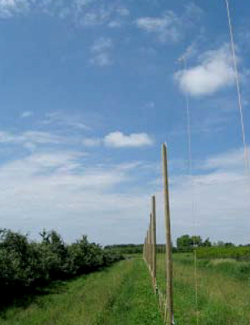Summary
Investigator: Matthew Grieshop, Assistant Professor of Organic Pest Management, Organic Pest Management Lab, Michigan State University, East Lansing, Michigan
Project location: AlMar Orchards, Flushing, Michigan
The high value of organic hops (up to $10,000/acre gross) makes them an especially attractive crop for small to midsize organic farms. Organic apple farmers may be especially well suited to hops production given the similarities between modern, high-density apple orchards and hops production. These similarities include: perennial production, the need for trellising or other structural support, as well as comparable harvest dates (August-October).
However, potential hops production in the upper Midwest also presents significant challenges such as selection of varieties well adapted to microclimatic conditions and local markets, development of realistic expectations for the cost of production, and assessment of potential pest management issues.
We established an experimental hopyard at AlMar orchards in Spring 2009 to answer some of these questions. Sixteen certified organic hop varieties were planted in a single trellised row. Hop varieties had representatives from both bittering and aromatic hops.
Project objectives were:
- To determine the economic cost and feasibility of utilizing high-density orchard technology (e.g. trellis and drip irrigation systems) and practices (i.e. orchard floor management, pest management tactics) for Michigan/Upper Midwest production of organic hops;
- To determine the relative suitability/productivity of hops varieties for Michigan/Upper Midwest conditions;
- To determine initial pest management challenges for organic hops produced under Michigan conditions.
The sixteen varieties of hops rhizomes planted were:
- Cascade, Centenial
- Chinook, Willamette
- Fuggle, Magnum
- Mt. Hood, Nugget
- Northern Brewer
- Perle
- Pride of Ringwood
- Sterling, Kent Golding
- Brewer’s Gold
- Galena
- Golding, obtained from The Thyme Garden Herb Company, Alsea Oregon.
Data collected in our first year of growing hops was limited by unusually cool summer conditions (the 10th coolest summer in Michigan recorded history) resulting in slower than expected hops vine development. Our efforts were focused on collecting data on the weekly growth of the 16 hops varieties and the relative abundance of pests. First year establishment of a hopyard using materials adapted from high density tree fruit cost approximately $7,317.
The two-spotted spider mite was our most serious pest with mite damage first observed in mid July and continuing until final harvest. Chinook, Pride of Ringwood, and Galena appeared to be less frequently attacked by two-spotted spider mite compared to the other hops varieties.
The first harvest of cones was on August 27, 2009, and the final harvest performed on September 24.

